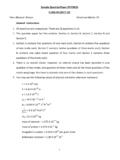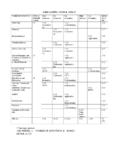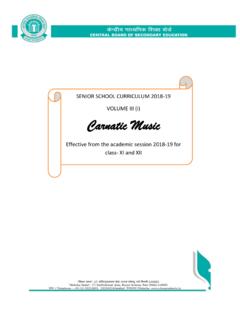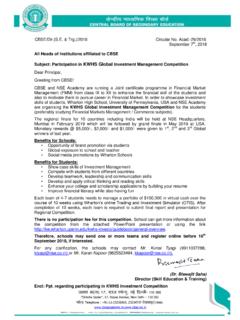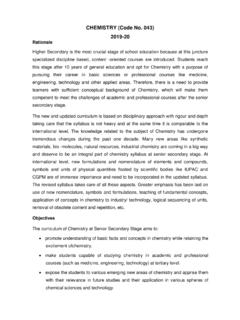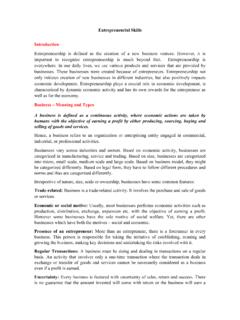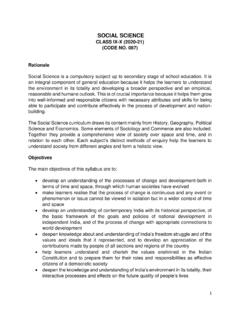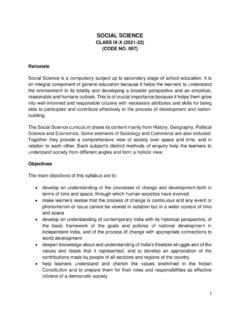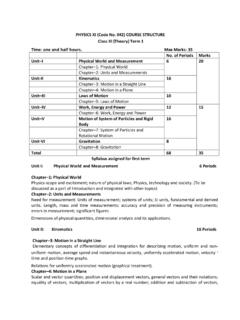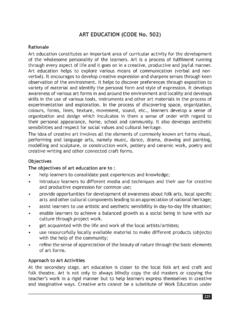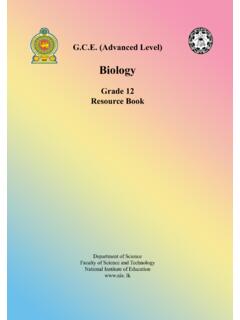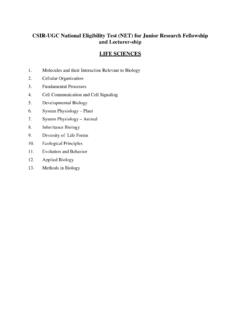Transcription of CLASS XI and XII (2021-22)
1 Page 1 of 11 BIOLOGY (Code No. 044) Syllabus for Purpose of Examination 2021-22 CLASS XI and XII (2021-22) The present curriculum provides the students with updated concepts along with an extended exposure to contemporary areas of the subject. The curriculum also aims at emphasizing the underlying principles that are common to animals, plants and microorganisms as well as highlighting the relationship of Biology with other areas of knowledge. The format of the curriculum allows a simple, clear, sequential flow of concepts. It relates the study of biology to real life through the use of technology. It links the discoveries and innovations in biology to everyday life such as environment, industry, health and agriculture.
2 The updated curriculum focuses on understanding and application of scientific principles, while ensuring that ample opportunities and scope for learning and appreciating basic concepts continue to be available within its framework. The curriculum is expected to: promote understanding of basic principles of Biology encourage learning of emerging knowledge and its relevance to individual and society promote rational/scientific attitude towards issues related to population, environment and development enhance awareness about environmental issues, problems and their appropriate solutions create awareness amongst the learners about diversity in the living organisms and developing respect for other living beings appreciate that the most complex biological phenomena are built on essentially simple processes It is expected that the students would get an exposure to various branches of Biology in the curriculum in a more contextual and systematic manner as they study its various units.
3 BIOLOGY (Code No. 044) COURSE STRUCTURE CLASS XI (2021 -22) EVALUATION SCHEME Theory Units Term I Marks I Diversity of Living Organisms: Chapter - 1, 2, 3 and 4 15 II Structural Organization in Plants and Animals: Chapter 5 and 7 08 III Cell: Structure and Function: Chapter 8 and 9 12 Units Term - II Marks III Cell: Structure and Function: Chapter - 10 05 IV Plant Physiology: Chapter - 13,14 and 15 12 V Human Physiology: Chapter 17, 18, 19, 20, 21 and 22 18 Total Theory (Term I and Term II) 70 Page 2 of 11 Practicals Term I 15 Practicals Term II 15 Total 100 THEORY Term I Unit-I Diversity of Living Organisms Chapter-1: The Living World What is living? Biodiversity; Need for classification; three domains of life; concept of species and taxonomical hierarchy; binomial nomenclature.
4 Chapter-2: Biological Classification Five kingdom classification; Salient features and classification of Monera, Protista and Fungi into major groups; Lichens, Viruses and Viroids. Chapter-3: Plant Kingdom Salient features and classification of plants into major groups - Algae, Bryophyta, Pteridophyta and Gymnospermae. (salient and distinguishing features and a few examples of each category). Chapter-4: Animal Kingdom Salient features and classification of animals, non-chordates up to phyla level and chordates up to CLASS level (salient features and distinguishing features of a few examples of each category). (No live animals or specimen should be displayed.) Unit-II Structural Organization in Animals and Plants Chapter-5: Morphology of Flowering Plants Morphology of inflorescence and flower, Description of 01 family: Solanaceae or Liliaceae (to be dealt along with the relevant experiments of the Practical Syllabus).
5 Chapter-7: Structural Organization in Animals Animal tissues. Unit-III Cell: Structure and Function Chapter-8: Cell-The Unit of Life Cell theory and cell as the basic unit of life, structure of prokaryotic and eukaryotic cells; Plant cell and animal cell; cell envelope; cell membrane, cell wall; cell organelles - structure and function; endomembrane system, endoplasmic reticulum, golgi bodies, lysosomes, vacuoles, mitochondria, ribosomes, plastids, microbodies; cytoskeleton, cilia, flagella, centrioles (ultrastructure and function); nucleus. Chapter-9: Biomolecules Chemical constituents of living cells: biomolecules, structure and function of proteins, Page 3 of 11 carbohydrates, lipids, nucleic acids; Enzymes- types, properties, enzyme action.
6 Term II Unit-III Cell: Structure and Function Chapter-10: Cell Cycle and Cell Division Cell cycle, mitosis, meiosis and their significance Unit-IV Plant Physiology Chapter-13: Photosynthesis in Higher Plants Photosynthesis as a means of autotrophic nutrition; site of photosynthesis, pigments involved in photosynthesis (elementary idea); photochemical and biosynthetic phases of photosynthesis; cyclic and non-cyclic photophosphorylation; chemiosmotic hypothesis; photorespiration; C3 and C4 pathways; factors affecting photosynthesis. Chapter-14: Respiration in Plants Exchange of gases; cellular respiration - glycolysis, fermentation (anaerobic), TCA cycle and electron transport system (aerobic); energy relations - number of ATP molecules generated; amphibolic pathways; respiratory quotient.
7 Chapter-15: Plant - Growth and Development Growth regulators - auxin, gibberellin, cytokinin, ethylene, ABA. Unit-V Human Physiology Chapter-17: Breathing and Exchange of Gases Respiratory organs in animals (recall only); Respiratory system in humans; mechanism of breathing and its regulation in humans - exchange of gases, transport of gases and regulation of respiration, respiratory volume; disorders related to respiration - asthma, emphysema, occupational respiratory disorders. Chapter-18: Body Fluids and Circulation Composition of blood, blood groups, coagulation of blood; composition of lymph and its function; human circulatory system - Structure of human heart and blood vessels; cardiac cycle, cardiac output, ECG; double circulation; regulation of cardiac activity; disorders of circulatory system - hypertension, coronary artery disease, angina pectoris, heart failure.
8 Chapter-19: Excretory Products and their Elimination Modes of excretion - ammonotelism, ureotelism, uricotelism; human excretory system structure and function; urine formation, osmoregulation; regulation of kidney function - renin - angiotensin, atrial natriuretic factor, ADH and diabetes insipidus; role of other organs in Page 4 of 11 excretion; disorders - uremia, renal failure, renal calculi, nephritis; dialysis and artificial kidney, kidney transplant. Chapter-20: Locomotion and Movement Skeletal muscle, contractile proteins and muscle contraction. Chapter-21: Neural Control and Coordination Neuron and nerves; Nervous system in humans - central nervous system; peripheral nervous system and visceral nervous system; generation and conduction of nerve impulse.
9 Chapter-22: Chemical Coordination and Integration Endocrine glands and hormones; human endocrine system - hypothalamus, pituitary, pineal, thyroid, parathyroid, adrenal, pancreas, gonads; mechanism of hormone action (elementary idea); role of hormones as messengers and regulators, hypo - and hyperactivity and related disorders; dwarfism, acromegaly, cretinism, goiter, exophthalmic goiter, diabetes, Addison's disease. Note: Diseases related to all the human physiological systems to be taught in brief. PRACTICALS Max. Marks: 15 for each Term Practicals should be conducted alongside the concepts taught in theory classes. A: List of Experiments TERM -I: 1. Study and describe a locally available common flowering plant, from any one family: Solanaceae or Liliaceae (Poaceae, Asteraceae or Brassicaceae can be substituted in case of particular geographical location) including dissection and display of floral whorls, anther and ovary to show number of chambers (floral formulae and floral diagrams).
10 2. Study of osmosis by Potato osmometer. TERM -II: Evaluation Scheme TERM-I TERM - II MARKS Part A One Major Experiment Experiment No. - 1 Experiment No. 3, 4 4 One Minor Experiment Experiment No. - 2 Experiment No. - 5, 6, 7 3 Part B Spotting (3 Spots of 1 mark each) , 2, 3 , 5 3 Practical Record + Investigatory Project& Record + Viva Voce 5 Total 15 Page 5 of 11 3. Separation of plant pigments through paper chromatography. 4. Study of distribution of stomata in the upper and lower surfaces of leaves. 5. Study of the rate of respiration in flower buds/leaf tissue and germinating seeds. 6. Test for presence of sugar in urine. 7. Test for presence of albumin in urine. B. Study/Observation of the following (spotting): TERM - I: Parts of a compound microscope.
